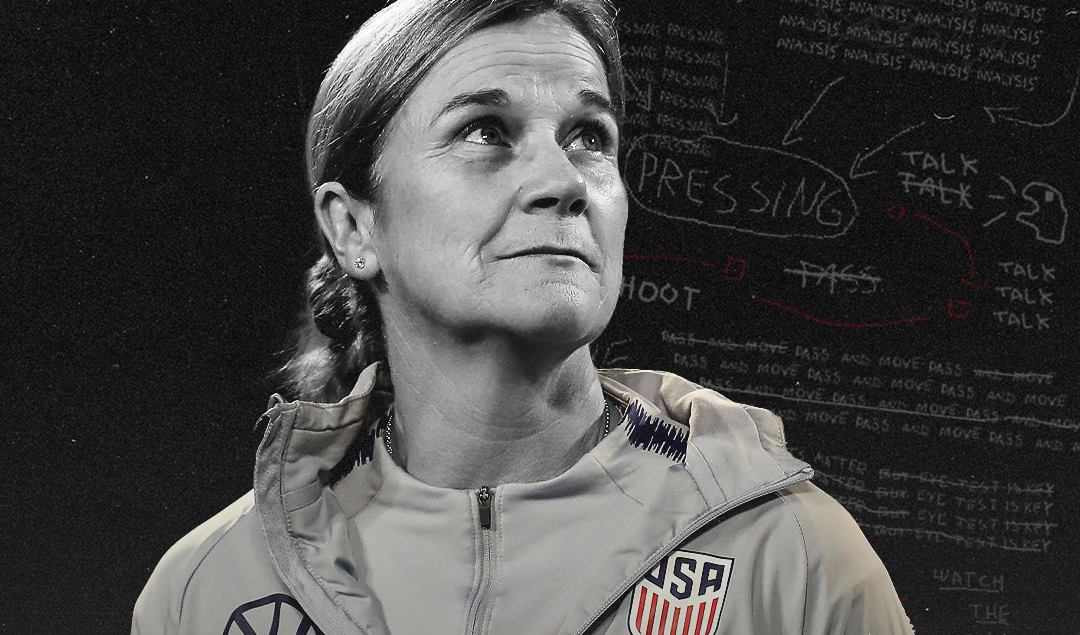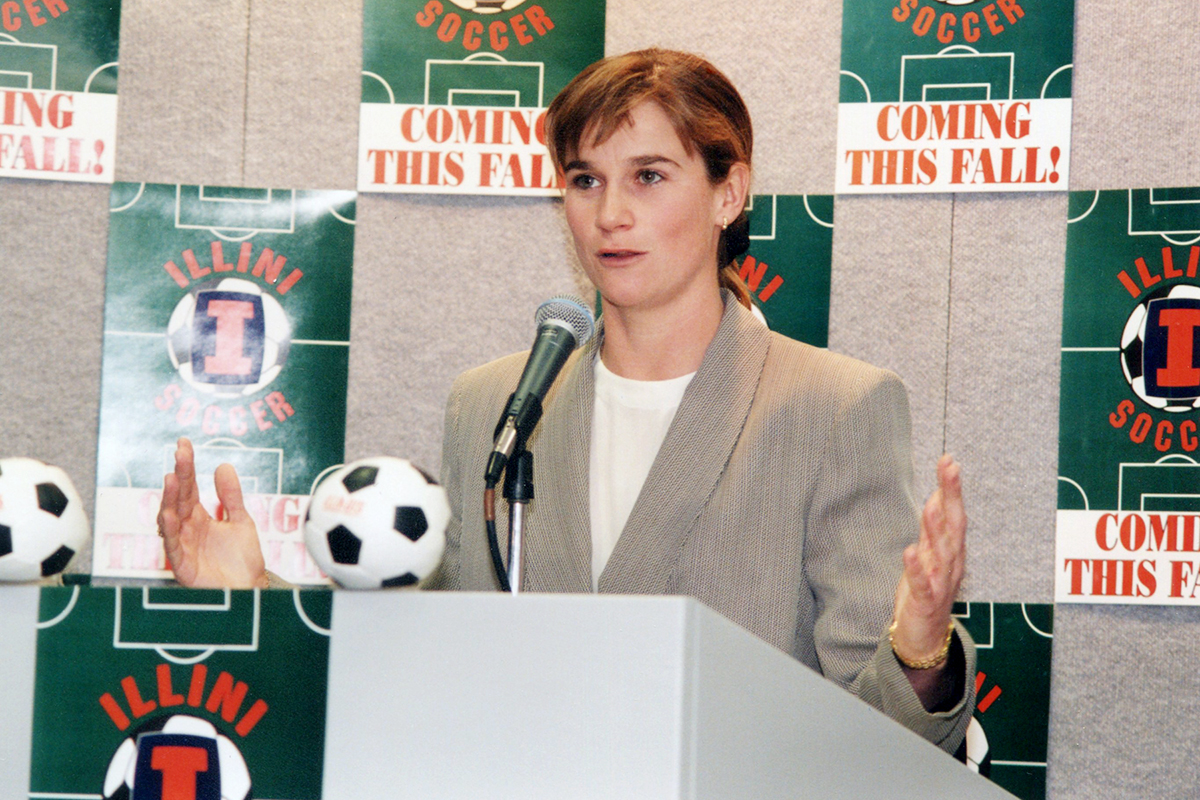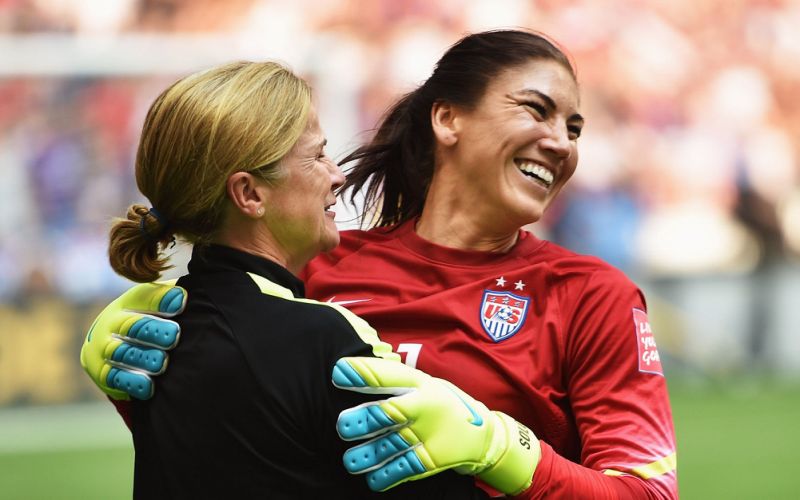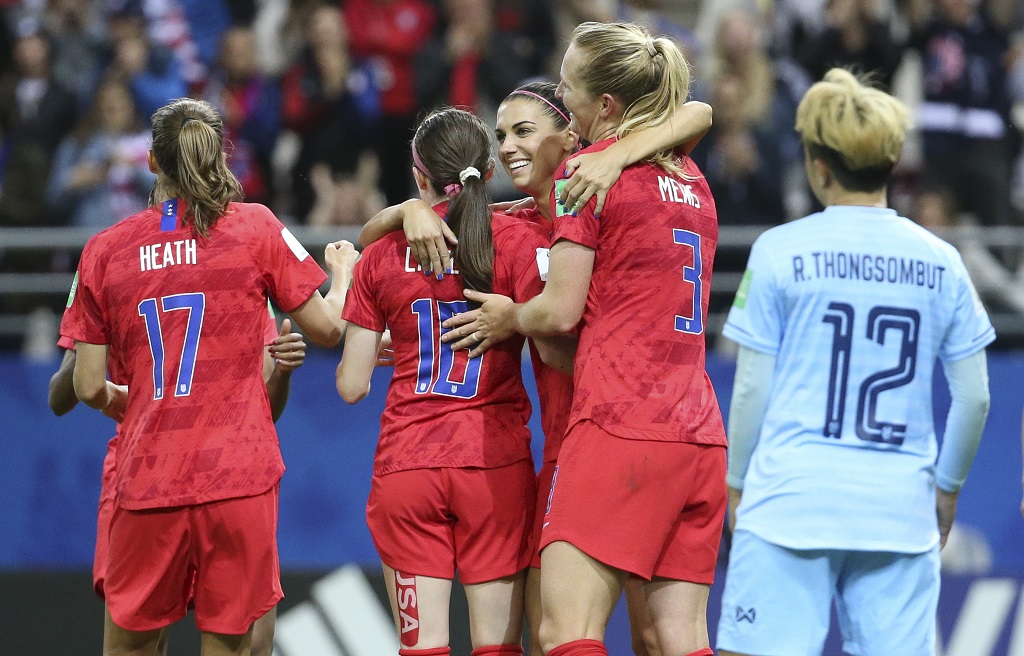Jill Ellis: A Hero Born Out of Scrutiny
Prior to 2019, only one manager in the history of football had won two successive World Cups. That man was Italy’s Vittorio Pozzo, who led his nation to football’s biggest prize in 1934 and 1938. With a star cast at his disposal, his innovativeness was great to watch and he etched his name as one of the game’s greatest tacticians. He was joined in this elite club this year by a woman who led the United States of America to two-successive World Cup honours: Jill Ellis.
For much of Ellis’ career, she has defied the odds and by the time she left her role as the coach of the United States women’s national team, she was vindicated. In her five years in charge, Ellis was involved in making difficult decisions, dealing with set-backs, destroying an old successful cycle and creating a new one that would be just as dominant. It is a testament to her and her managerial abilities that she has come so far and done so well after a few testing phases.
Ellis had been involved with the country’s football programme for two decades prior to getting the job as the permanent head coach of the women’s national team. Just like how many American athletes and coaches start off, the Hampshire-born Ellis, began at university level, picking up experience in North Carolina, Virginia and Maryland as an assistant in the 1990s. These were crucial formative years and by the time she stopped coaching at college level in 2010, she had an impressive record of 248 wins, 63 losses and 14 draws.
Coaching, however, was never meant to be her primary task. When she moved to the US at the age of 15, football caught her eye and in 1992, April Heinrichs, the captain of team USA at the 1991 World Cup, recognised her efforts in helping her father in coaching camps.
When speaking to The Guardian in 2015, Ellis admitted it was a massive leap of faith: “I took a $40k pay cut to leave my technical copywriter job and work for $6k a year. My mom said: ‘Are you nuts?’”
It came as no surprise that with a record like that, she would be part of the national setup. Women’s football in the United States was growing. After they had won the World Cup in 1991 and 1999 and with players like Mia Hamm, Michelle Akers, Heinrichs and more, the sport was at its highest point in the 2000s. New talent was coming in – Carli Lloyd and Abby Wambach were stepping up to be potent forwards, whilst Hope Solo was an emerging goalkeeper. It was during this time that Ellis was given the reins of the country’s youth teams.
Photo: Illinois Athletics
Her presence in the US women’s soccer setup was highly respected. Along with leading the under-20s and under-21s to participating and winning tournaments abroad, Ellis was also a part of Pia Sundhage’s coaching staff that won gold at the 2008 Olympic Games in Beijing. Along with that, she had also previously been a scout for the national team eight years prior for the Sydney Games, before taking on the role of the national team’s Development Director. Her success warranted big responsibility, and in 2012, it came.
After Sundhage stepped down to return to Sweden, Ellis was appointed as the interim coach of the senior team. Replacing the Swedish manager was no easy feat. She had won two Olympic gold medals with the side whilst also taking them to the World Cup final in 2011, where they finished as runners-up. She had overseen a huge transition, bringing in players like Alex Morgan and Megan Rapinoe into the setup, and now the team’s future was up in the air. Ellis’ job was to take Sundhage’s good work forward.
As the interim coach, Ellis won five out of her seven games in charge, drawing the other two. Although her stint was short-lived, her story wasn’t done there. Two years later, after Tom Sermanni was sacked, Ellis returned at the helm – initially on a temporary basis – and she never looked back. Taking over in a year before the World Cup is never easy, and especially in this environment, where the players had revolted against the former coach, Ellis had a big task on her hands.
The USA had gone 16 years and several near-misses since winning the World Cup, and the early months were hardly smooth sailing for Ellis. Her selections and tactics were frequently scrutinized. Some of the team’s early results included a defeat against France and draws against Iceland and South Korea, which raised question marks about whether she was the right woman for the job. Her most senior player, Wambach, however, was confident and heading into the World Cup, she gave her backing to the coach.
Ellis’ side were drawn in the toughest group of the competition, coming up against Australia, Sweden and Nigeria. A meeting against her former boss Sundhage was on the cards, but along with that, there were two complicated fixtures to navigate past. Even star forward Morgan was struggling with a persistent knee injury, meaning that the pressure on Ellis was vast. At the finals, however, the USA were at their best, and while the doubt still lived on amongst the media, confidence grew amongst the players.
They qualified through their group with ease, as Rapinoe’s fine form combined with the overall experience of the side came good. They won two matches – against Australia and Nigeria – and drew the fixture against Sweden, qualifying as group winners. Despite the form, Ellis was still scrutinized: for some, she was too defensive; for some, she lacked boldness; for some, she was just lucky to have good players; for some, she was making the wrong selections. Being the coach of the world’s most renowned women’s team was a difficult task.
It never deterred Ellis, though. She and the team carried on with their jobs, overcoming Colombia with ease in the second round, before dispatching China in the semi-final. In the knockout rounds, the USA were unbeatable and it was the semi-final that she made an inspired switch. Against Germany, Ellis deployed the lethal Lloyd as Morgan’s partner up top, and having seen her score in the previous two games, it was hard to bet against her from striking once again.
Photo: Michael Chow-USA TODAY Sports
Lloyd ended up on the scoresheet, albeit from the penalty spot, as the USA progressed to the final having beaten the Germans 2-0, with Kelley O’Hara netting the second. In the final, they would face Japan in a repeat of the final from four years ago. That year, there was heartache after a penalty shoot-out and there were several players from that squad who were still playing: the likes of Rapinoe, Morgan, Lloyd, Wambach and Heath, amongst others, were all keen on undoing the wrongs of four years prior.
This match in Vancouver, however, was different gravy. Lloyd, retaining her spot as the forward, struck early on, and then again, and then spectacularly for a third time from her own half. A hat-trick within 16 minutes shook the Japanese and the final was all but over before the 20th minute. Even Lauren Holiday scored once as the USA went into half-time leading 4-1. A flurry of goals for either side early in the second-half didn’t mean much as Ellis’ side held on to win 5-2 in a dramatic afternoon.
Prior to the tournament, there were skeptics suggesting Ellis wasn’t the right person for the job. During the tournament, there were people who believed this team wouldn’t go far. After the tournament, surprisingly, there were people who downplayed her work, stating that her decision to push Lloyd forward wasn’t her own making and only down to circumstance, but in the end only one thing mattered: the USA and Ellis were world champions, and this was a thoroughly deserved honour.
While there was belief that this was the best team in women’s football, Ellis and the USA had to prove themselves again at the Olympic Games, which were to be held in Rio de Janeiro in the following summer. After winning gold in London four years prior, the world champions were tipped to go all the way once again. When they got there, however, they didn’t go far. The USA eased through the group stages, easily dispatching France, New Zealand and Colombia, but their run ended in the second round.
Coming up against Sundhage’s Sweden, they were sluggish and unable to break the stern defensive line. The Swedes earned first blood as Emma Blackstenius scored first, but that lead was cut through Morgan. After 120 minutes of a difficult encounter, it came down to penalties, where Morgan and Christen Press’ misses cost the team, and the USA went out in disappointing fashion. Once again, the underachievement raised concerns over Ellis’ management, and this time, it had mass repercussions.
In the aftermath, the USA’s outspoken goalkeeper, Solo, labeled the victors as “a bunch of cowards” and went after their defensive tactics. Those comments didn’t go down too well and resulted in Solo receiving a six-month suspension from the team.
Eventually, the suspension led to a termination, and the goalkeeper’s time with the USWNT was over. The feud between Solo and Ellis didn’t end there, however. Prior to the 2019 World Cup, Solo claimed that Ellis “cracks under pressure” and also believed she wasn’t the right woman to take the team forward.
Photo: Getty Images
After the Olympics, there was further drama amongst the suits at the United States Soccer Federation. According to Sports Illustrated, a group of senior players told the then-president, Sunil Gulati, that they wanted a new coach at the helm, but the federation didn’t follow through. They didn’t believe it was fair to sack Ellis after a shoot-out loss at the Olympics, having won the World Cup 12 months prior. Instead, Ellis had her role and invested her time in changing the way things were done.
Solo was the first to go, with Alyssa Naeher brought in as the first-choice. After that, Crystal Dunn moved from being an attacking player to a left-back; the same happened with O’Hara; Julie Ertz, a central defender at domestic level was moved into defensive midfield while other talents such as Rose Lavelle and Mal Pugh were integrated into the senior team. Several players that were part of the side that lost at the Olympics were phased out or dropped completely, and this was a new team that was set to take over.
For the most part, the change of cycle worked. In 2018, the USA romped to victories in the SheBelieves Cup, the Tournament of Nations and the CONCACAF Women’s Championship, overcoming top sides like Brazil, England and Canada and once again, confidence was high. The players that remained from the previous cycle: Morgan, Rapinoe and Lloyd were firing once again, while Lavelle enjoyed a steady welcome to the team. Once again, the USA were strongly fancied to win the World Cup, however, the high expectation brought the usual criticism.
In 2019, poor displays against France and Spain made many believe that Ellis has done too much too quickly. The decisions to replace older players with younger inexperienced talent didn’t go down well, and failure to win at the 2019 SheBelieves Cup only intensified fury.
One particular decision – not fielding Lindsey Horan more often – didn’t go down well and seeing as other nations such as England and the Netherlands were stepping up, the locals knew that the USA had a tough job on their hands if they were to retain the World Cup.
There were further reports that another coup, similar to the one in 2017, was planned in a bid to have another coach, but those rumours were quickly squashed. A 5-3 win over Australia two months before kick-off in France didn’t help matters – there was too much displeasure about the leaky defence, an area that saw plenty of change since the Olympic Games. Going into the finals, Ellis’ was under pressure, but she silenced critics in the only way she knew: by showing it all off on the pitch.
In the opening match of the World Cup in France, the USA squashed Thailand 13-0, with Morgan netting five as they set the record for the biggest margin of victory in a single World Cup match. The rampant Americans then followed that up with 3-0 and 2-0 wins over Chile and Sweden respectively, and all of a sudden, everyone was back on their side. Detractors cited bad substitutions and selections, poor in-game management and whatnot, but this team and coach only had one objective in mind.
Photo: Jean Catuffe/Getty Images
The build-up to the second-round clash was dominated by Rapinoe’s comments about her team’s refusal to visit Donald Trump’s administration at the White House, should they win the World Cup, but even all of that media attention – and even political pressure from Trump’s response – didn’t stop the team. Rapinoe put her money where her mouth was, netting twice and gloriously celebrating to send all of America into jubilation – perhaps with the exception of one man.
Rapinoe struck twice again in the quarter final, this time against hosts, France. In the capital, the pink-haired forward was in incredible form as she put aside all the media attention and placed all her focus on the task in hand. Unlike much of the doubts raised prior to the tournament, the USA were stern and solid at the back, hardly giving France a chance. Wendie Renard scored for the hosts late on, but it wasn’t enough. The USA were in the last four, and there was nothing to suggest it would go wrong.
Rapinoe missed the semi-final against England due to injury, but it was time for the other senior names to step up. Her replacement, Press scored early on and after an English equaliser, Morgan added the second and performed her famous tea cup celebration. This was a team of superstars – a group with all the confidence in the world who perhaps deservedly felt they had the right to show off all their swagger on the field – and they were doing just that. The USA held on and qualified for their third-successive World Cup final. History was close.
In the final against the Netherlands, the team faced their toughest challenge. It was the first time all tournament that they had failed to score in the opening 15 minutes, but the team didn’t lose hope. A third of the way through the second-half, the Americans won a penalty, which was easily converted by the returning Rapinoe. Soon after, Lavelle, who was one of the beneficiaries of Ellis’ changing selection cycle, doubled their lead and in consecutive editions, the USA were world champions.
From scrutiny for much of her time in charge to double world champions, at the final whistle in Lyon, Ellis was vindicated. The USA won the World Cup in style, winning all of their matches and being icons on and off the pitch. It was a worthy reward for a changing phase that had lasted nearly three years. Involving risk-taking, tough decision-making, controversy and media scrutiny, the success at the end of it all tasted sweet. Ellis left her role in October 2019 after her team’s celebrations and was rightly praised all round.
Having taken over a team of gold medalists and helped them onto greater success is by no means an easy feat and Ellis deserves acclaim for that. Her next role in coaching is unclear but no matter where she goes, her employers have an incredible coach on their books. A composed figure on the touchline who always has things under control, Ellis is arguably the greatest coach in the history of women’s football.
By: Karan Tejwani
Featured Image: @GabFoligno / Streeter Lecka – Getty Images
This article was originally published on Football Chronicle.




